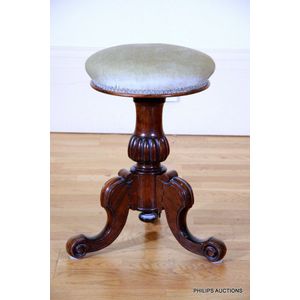Victorian French-style Walnut Teapoy
You must be a subscriber, and be logged in to view price and dealer details.
Subscribe Now to view actual auction price for this item
When you subscribe, you have the option of setting the currency in which to display prices to $Au, $US, $NZ or Stg.
- Circa - A Latin term meaning 'about', often used in the antique trade to give an approximate date for the piece, usually considered to be five years on either side of the circa year. Thus, circa 1900 means the piece was made about 1900, probably between 1895 and 1905. The expression is sometimes abbreviated to c.1900.
- Veneers - Veneers are thin sheets of well-figured timber that are glued under pressure to the surface of a cheaper timber for decorative effect, and then used in the making of carcase furniture.
Early veneers were saw-cut so were relatively thick, (up to 2 mm) but is was realised that saw cutting was wasteful, as timber to the equivilent of the thickness of the saw was lot on each cut.
A more efficient method was devised to slice the timber, either horizontally with a knife, or in a rotary lathe.
Flame veneer, commonly found in mahogany or cedar furniture, is cut from the junction of the branches and main trunk. So-called fiddleback veneers, where the grain is crossed by a series of pronounced darker lines, is usually cut from the outer sections of the tree trunk.
During the 17th and 18th centuries, and in much of the walnut marquetry furniture made during the latter part of the 19th century, the veneer was laid in quarters, each of the same grain, so that one half of the surface was the mirror image of the other.
The use of veneer allows many other decorative effects to be employed, including stringing, feather banding, cross banding, and inlaid decorative panels in the piece. The carcase over which veneer is laid is usually of cheaper timber such as pine, oak or, sometimes in Australia during the first half of the 19th century, red cedar.
The important thing to remember about veneers is that prior to about 1850 they were cut by hand, and were consequently quite thick - ranging up to about 2mm deep.
From the mid-19th century veneers were cut by machines and were almost wafer-thin. This is a critical point when trying to judge the approximate age of veneered furniture. - Burr - Burr (or in the USA, burl) is the timber from the knotted roots or deformed branch of the tree, which when cut, displays the small circular knots in various gradations of colour. It is always cut into a decorative veneer, most commonly seen as burr walnut on 19th century furniture.
- Egg and Dart Moulding - A decorative element consisting of a row of oval shapes, generally vertical, and spaced with pointed darts or tongues. Originally derives from the architectural decorations of classical antiquity, and the feature can be found on bookcases, mirrors and tables and other furniture imitating the classical style.
- Victorian Period - The Victorian period of furniture and decorative arts design covers the reign of Queen Victoria from 1837 to 1901. There was not one dominant style of furniture in the Victorian period. Designers used and modified many historical styles such as Gothic, Tudor, Elizabethan, English Rococo, Neoclassical and others, although use of some styles, such as English Rococo and Gothic tended to dominate the furniture manufacture of the period.
The Victorian period was preceded by the Regency and William IV periods, and followed by the Edwardian period, named for Edward VII (1841 ? 1910) who was King of the United Kingdom and the British Dominions and Emperor of India for the brief period from 1901 until his death in 1910. - Wrythen - A spirally twisted ornamentation most commonly found on antique glass, silver, ceramics and furniture.
This item has been included into following indexes:
Visually similar items

A small Victorian inlaid walnut occasional table, circa 1860s-70s, the table having a relief carved border enclosing a finely figured top with Sheraton style stringing in boxwood above a corkscrew and knopped stem to a tripod base with swept cabriole legs

A Victorian mahogany tripod based piano stool, 19th century, with maker's mark, Charles Wadman, Bath, no. 6693, with a shaped and reeded pedestal to sweeping legs with whorl feet, the stuffover seat upholstered in sage velvet, height 52 cm

A Victorian walnut provincial tripod table, circa 1860s, circular with a carved rose and thistle border upon a barley twist and striking foliate ball stem, and with outswept cabriole scroll and foliate legs with casters. Height 80 cm. Diameter 60 cm.

A mid Victorian burr walnut kidney shaped occasional table, 74 cm high. 91 cm wide, 50 cm deep
